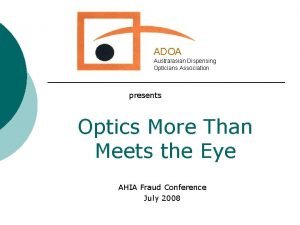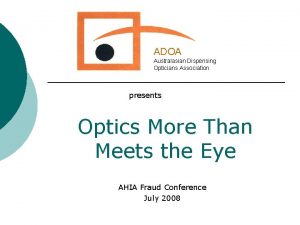OPTICIANS INDUSTRY OVERVIEW The retail optical industry in















- Slides: 15

OPTICIANS

INDUSTRY OVERVIEW § The retail optical industry in the US includes about 13, 000 optician stores with combined annual revenue of about $8 billion. Major companies include Eye Care Centers of America, Luxottica Retail (Lens. Crafters and Pearle Vision), and US Vision. The industry is concentrated: the 50 largest companies generate about 65 percent of segment revenue. § Opticians sell eyeglasses and contact lenses in retail stores based on prescriptions written by optometrists or ophthalmologists. § Optometrists are covered in a separate profile.

COMPETITIVE LANDSCAPE § Demand is driven by demographics, fashion, and changing healthcare practices. Most important is the aging of the US population, which is increasing demand for eye exams and glasses. Large retailers enjoy economies of scale in purchasing and can offer a wider range of product styles. Small retailers can often compete successfully with large chains by offering convenient locations, specialized products, or superior service. Eyeglass purchases are mildly cyclical with the economy, as many consumers view extra glasses as an expense that can be deferred. The industry is labor-intensive: average annual revenue per employee is about $125, 000.

PRODUCTS, OPERATIONS & TECHNOLOGY § Opticians sell eyeglasses and contact lenses in retail stores based on prescriptions written by optometrists or ophthalmologists. Often stores employ an on-site optometrist who performs eye exams; optometrists may also own and operate retail stores. Lenses and frames account for the bulk of store sales. Frames, which come in enormous variety and a wide range of prices, are often branded and can produce high markups, while contact lenses and lenses for glasses are mostly commodity items with fairly low margins. A typical store may hold an inventory of 500 frames in 100 different styles. The price range of frames a store carries depends on the demographics of local shoppers. Opticians also sell non-prescription products like sunglasses and reading glasses (magnifiers).

PRODUCTS, OPERATIONS & TECHNOLOGY § Contact lenses come in hard or soft varieties, may be colored, and may allow extended wear or be disposable. The lenses for glasses also come in various colors and with various coatings and may contain areas of different correction (bi- or tri-focals). "Progressive" lenses are bifocals with the corrective areas smoothly blended into each other. Simple conditions, like near- or far-sightedness, can be corrected with either contact lenses or glasses, while some can best be corrected with glasses.

PRODUCTS, OPERATIONS & TECHNOLOGY § Because the lenses for glasses must be ground, coated, and shaped to fit a particular frame, some retail stores have an attached optical laboratory, while others send such work out to a company-owned or independent laboratory. Some stores with an attached lab can produce a finished pair of glasses in an hour, but the usual turnaround time is several days. § Lenses for glasses are made of plastic and are bought from a few large manufacturers, such as Carl Zeiss Vision. Frames are usually bought from a dozen manufacturers, but stores may carry a large number of brand names. Contact lenses are made by such companies as Bausch & Lomb, Johnson & Johnson, and CIBA VISION.

SALES & MARKETING § Typical customers are consumers in need of eye exams and corrective lenses. Optician stores, like other retail stores, try to locate in areas of high shopper traffic like shopping malls or near office buildings; much of their business is walk-ins. § Because state regulations require a prescription for corrective lenses, many stores have an optometrist on-site or in an adjacent office. Some large chains bundle a retail store with an optometrist and a lab. Some chains operate stores within larger department or warehouse stores. Marketing for independent stores is largely limited to Yellow Pages advertising and window displays. Chains use local TV, radio, newspaper, and online advertising and often group several stores within a market to make advertising more cost-effective.

SALES & MARKETING § Although health insurance plans increasingly cover eye exams, vision plans are more common in the industry. Consumers covered under vision care plans are two or three times more likely to have an eye exam than patients who have vision coverage in their health plan, according to the National Association of Vision Care Plans. § Internet sales of eyeglasses is a growing sector. The Federal Trade Commission’s Contact Lens and Eyeglass Rules requires optometrists to give patients their eyeglass prescription so they can buy their glasses wherever they want. Buying eyeglasses online is more complex than buying contact lenses, however, as opticians must make additional measurements.

INDUSTRY FORECAST § US personal consumer expenditures on ophthalmic and orthopedic equipment, an indicator of demand for opticians, are forecast to grow at an annually compounded rate of 4 percent between 2012 and 2015. Data Published: March 2012 Consumer spending growth on ophthalmic goods fluctuates 0 § First Research forecasts are based on INFORUM forecasts that are licensed from the Interindustry Economic Research Fund, Inc. (IERF) in College Park, MD. INFORUM's "interindustry-macro" approach to modeling the economy captures the links between industries and the aggregate economy. Forecast FAQs

CRITICAL ISSUES § Insurance and Vision Plans - Opticians usually participate in one or more vision plans, which give customers discounts on frames and glasses. Some large chains manage their own vision plans. Health insurance plans are also increasing coverage of eye exams. Additionally, medical flexible spending accounts (FSA) and health spending accounts (HSA) allow consumers to use money in those accounts for eye exams and expenses. Keeping track of the variety of vision plans and insurance benefits may be complex, could increase receivables, and require opticians to accept insurance companies' allowable charges. § Competition from Mass Merchants - Mass merchants like Wal-Mart have opened optical departments within their stores in recent years and generally offer lower prices than many independent stores or chains. Although these companies compete mainly at the lower end of the market, they affect higher end prices as well. Many chains, such as Luxottica Retail, run the optical departments of department stores.

BUSINESS CHALLENGES § Improved Corrective Eye Surgery May Shrink Optical Market - Although corrective eye surgery like LASIK has so far had no major impact on sales of glasses and contact lenses, the volume of such surgery is expected to increase as quality improves and costs decrease. Instead of marketing eyeglasses solely as vision correction, opticians may have to revise their approach to eyewear as eye protection or as a fashion statement. § Internet Sales of Contact Lenses, Glasses - Internet sales of contact lenses have grown tremendously, since all that is required is a prescription. New technology has also improved the ability of Internet optical stores to fit frames and lenses to an individual's face, crucial to a good fit and effective vision correction. As a result, bricks-and-mortar optical stores are seeing increased competition from online stores, which can sell their products more cheaply, are perceived to have a better selection, and are considered more convenient.

BUSINESS TRENDS § Aging US Population - The US population between the ages of 45 and 64 is expected to number more than 84 million by 2020. This group has the most rapid change in the quality of vision, has frequent eye examinations, and can afford to buy multiple pairs of glasses and contact lenses. This age group is also at higher risk for diabetes, which can cause deteriorating vision, requiring more care. § Glasses as Fashion Statement - With the popularity of designer frames, glasses are no longer simply for vision correction. Thinner, lightweight lenses with specialized coatings and other functionality mean that eyeglasses can be a fashion statement and can be used to enhance the wearer’s features. Opticians are trained to recommend frames that look the best on the customer.

INDUSTRY OPPORTUNITIES § Boutique Services - Some opticians are moving into high-end services to differentiate themselves from mass-market and Internet stores. For example, providing specialty lab services to create one-of-a-kind eyewear can be a lucrative market, especially with advances in technology and changing fashion trends. Standing out among the competition is crucial to an optician’s success in a crowded market, in which many customers shop by price. § Sports Eyewear - Athletes have special requirements for glasses. For example, golfers require different levels of polarization in their lenses that regular sunglasses don’t provide. Safety and sun protection are also issues. Opticians who provide sports eyewear to dedicated athletes, whether professional or amateur, can benefit from the fact that many of these customers will have high discretionary income and will be motivated to buy eyewear that can help them improve their performance.

INDUSTRY OPPORTUNITIES § Customized Vision Correction - New sensing technology that measures the specific vision deficiencies of an individual eye have resulted in customized eyeglasses that provide superior vision, and artificial lenses that correct for natural aging of the eye. Ophthonix is developing a measurement device for optometrists that will allow lenses to be crafted to correct individual eye aberrations, beyond simple near- or far-sightedness. Even customers with 20/20 vision may be able to improve their eyesight.

Title § Body copy
 Arthur weitz opticians
Arthur weitz opticians Pitlochry opticians
Pitlochry opticians Optical industry
Optical industry Retail communication objectives
Retail communication objectives Human resources in retail management process consists of
Human resources in retail management process consists of Industry analysis of apple
Industry analysis of apple Why consulting
Why consulting Telecom industry overview
Telecom industry overview Project management in retail industry
Project management in retail industry Industry life-cycle model
Industry life-cycle model Discount retail industry
Discount retail industry Retail management bi
Retail management bi Sơ đồ cơ thể người
Sơ đồ cơ thể người Tư thế ngồi viết
Tư thế ngồi viết Hình ảnh bộ gõ cơ thể búng tay
Hình ảnh bộ gõ cơ thể búng tay đặc điểm cơ thể của người tối cổ
đặc điểm cơ thể của người tối cổ





























